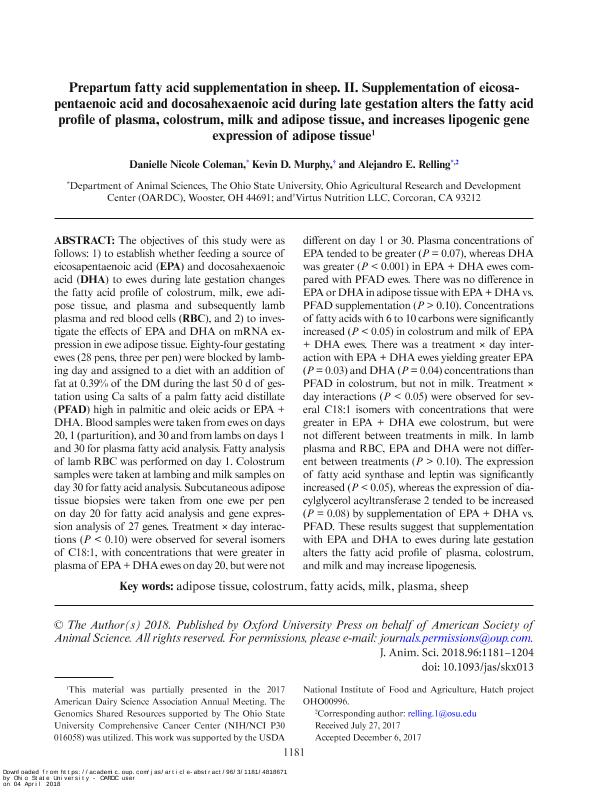Mostrar el registro sencillo del ítem
dc.contributor.author
Coleman, Danielle Nicole
dc.contributor.author
Murphy, Kevin D.
dc.contributor.author
Relling, Alejandro Enrique

dc.date.available
2019-10-22T16:54:00Z
dc.date.issued
2018-04
dc.identifier.citation
Coleman, Danielle Nicole; Murphy, Kevin D.; Relling, Alejandro Enrique; Prepartum fatty acid supplementation in sheep. II. Supplementation of eicosapentaenoic acid and docosahexaenoic acid during late gestation alters the fatty acid profile of plasma, colostrum, milk and adipose tissue, and increases lipogenic gene expression of adipose tissue; American Society of Animal Science; Journal of Animal Science; 96; 3; 4-2018; 1181-1204
dc.identifier.issn
0021-8812
dc.identifier.uri
http://hdl.handle.net/11336/86886
dc.description.abstract
The objectives of this study were as follows: 1) to establish whether feeding a source of eicosapentaenoic acid (EPA) and docosahexaenoic acid (DHA) to ewes during late gestation changes the fatty acid profile of colostrum, milk, ewe adipose tissue, and plasma and subsequently lamb plasma and red blood cells (RBC), and 2) to investigate the effects of EPA and DHA on mRNA expression in ewe adipose tissue. Eighty-four gestating ewes (28 pens, three per pen) were blocked by lambing day and assigned to a diet with an addition of fat at 0.39% of the DM during the last 50 d of gestation using Ca salts of a palm fatty acid distillate (PFAD) high in palmitic and oleic acids or EPA + DHA. Blood samples were taken from ewes on days 20, 1 (parturition), and 30 and from lambs on days 1 and 30 for plasma fatty acid analysis. Fatty analysis of lamb RBC was performed on day 1. Colostrum samples were taken at lambing and milk samples on day 30 for fatty acid analysis. Subcutaneous adipose tissue biopsies were taken from one ewe per pen on day 20 for fatty acid analysis and gene expression analysis of 27 genes. Treatment × day interactions (P < 0.10) were observed for several isomers of C18:1, with concentrations that were greater in plasma of EPA + DHA ewes on day 20, but were not different on day 1 or 30. Plasma concentrations of EPA tended to be greater (P = 0.07), whereas DHA was greater (P < 0.001) in EPA + DHA ewes compared with PFAD ewes. There was no difference in EPA or DHA in adipose tissue with EPA + DHA vs. PFAD supplementation (P > 0.10). Concentrations of fatty acids with 6 to 10 carbons were significantly increased (P < 0.05) in colostrum and milk of EPA + DHA ewes. There was a treatment × day interaction with EPA + DHA ewes yielding greater EPA (P = 0.03) and DHA (P = 0.04) concentrations than PFAD in colostrum, but not in milk. Treatment × day interactions (P < 0.05) were observed for several C18:1 isomers with concentrations that were greater in EPA + DHA ewe colostrum, but were not different between treatments in milk. In lamb plasma and RBC, EPA and DHA were not different between treatments (P > 0.10). The expression of fatty acid synthase and leptin was significantly increased (P < 0.05), whereas the expression of diacylglycerol acyltransferase 2 tended to be increased (P = 0.08) by supplementation of EPA + DHA vs. PFAD. These results suggest that supplementation with EPA and DHA to ewes during late gestation alters the fatty acid profile of plasma, colostrum, and milk and may increase lipogenesis.
dc.format
application/pdf
dc.language.iso
eng
dc.publisher
American Society of Animal Science

dc.rights
info:eu-repo/semantics/openAccess
dc.rights.uri
https://creativecommons.org/licenses/by-nc-sa/2.5/ar/
dc.subject
ADIPOSE TISSUE
dc.subject
COLOSTRUM
dc.subject
FATTY ACIDS
dc.subject
MILK
dc.subject
PLASMA
dc.subject
SHEEP
dc.subject.classification
Producción Animal y Lechería

dc.subject.classification
Producción Animal y Lechería

dc.subject.classification
CIENCIAS AGRÍCOLAS

dc.title
Prepartum fatty acid supplementation in sheep. II. Supplementation of eicosapentaenoic acid and docosahexaenoic acid during late gestation alters the fatty acid profile of plasma, colostrum, milk and adipose tissue, and increases lipogenic gene expression of adipose tissue
dc.type
info:eu-repo/semantics/article
dc.type
info:ar-repo/semantics/artículo
dc.type
info:eu-repo/semantics/publishedVersion
dc.date.updated
2019-09-27T14:53:05Z
dc.journal.volume
96
dc.journal.number
3
dc.journal.pagination
1181-1204
dc.journal.pais
Estados Unidos

dc.journal.ciudad
Urbana
dc.description.fil
Fil: Coleman, Danielle Nicole. The Ohio State University, Ohio Agricultural Research and Development, Department of Animal Sciences; Estados Unidos
dc.description.fil
Fil: Murphy, Kevin D.. Virtus Nutrition LLC, Corcoran; Estados Unidos
dc.description.fil
Fil: Relling, Alejandro Enrique. The Ohio State University, Ohio Agricultural Research and Development, Department of Animal Sciences; Estados Unidos. Consejo Nacional de Investigaciones Científicas y Técnicas. Centro Científico Tecnológico CONICET- La Plata. Instituto de Genética Veterinaria "Ing. Fernando Noel Dulout". Universidad Nacional de La Plata. Facultad de Ciencias Veterinarias. Instituto de Genética Veterinaria; Argentina. Virtus Nutrition LLC, Corcoran; Estados Unidos
dc.journal.title
Journal of Animal Science

dc.relation.alternativeid
info:eu-repo/semantics/altIdentifier/doi/http://dx.doi.org/10.1093/jas/skx013
dc.relation.alternativeid
info:eu-repo/semantics/altIdentifier/url/https://academic.oup.com/jas/article/96/3/1181/4818671
Archivos asociados
